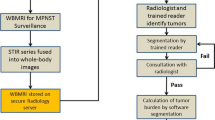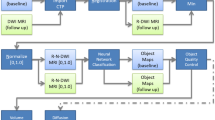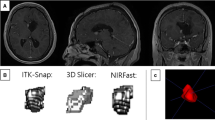Abstract
Purpose
Volumetric measurements of plexiform neurofibromas (PNs) are time consuming and error prone, as they require the delineation of the PN boundaries, which is mostly impractical in the daily clinical setup. Accurate volumetric measurements are seldom performed for these tumors mainly due to their great dispersion, size and multiple locations. This paper presents a semiautomatic method for segmentation of PN from STIR MRI scans.
Methods
Plexiform neurofibroma interactive segmentation tool (PNist) is a new tool to segment PNs in STIR MRI scans. The method is based on histogram tumor models computed from a training set.
Results
Experimental results from 28 datasets show an average absolute volume difference of 6.8 % with an average user time of approximately 7 min versus more than 13 min with manual delineation. In complex cases, the PNist user time is less than half in compared to state-of-the-art tools.
Conclusions
PNist is a new method for the semiautomatic segmentation of PN lesions. Its simplicity and reliability make it unique among other state-of-the-art methods. It has the potential to become a clinical tool that allows the reliable evaluation of PN burden and progression.











Similar content being viewed by others
References
Cai W, Kassarjian A, Bredella MA, Harris GJ, Yoshida H, Mautner VF, Wenzel R, Plotkin SR (2009) Tumor burden in patients with neurofibromatosis types 1 and 2 and schwannomatosis: determination on whole-body MR images1. Radiology 250(3):665–673
Eisenhauer E, Therasse P, Bogaerts J, Schwartz L, Sargent D, Ford R, Dancey J, Arbuck S, Gwyther S, Mooney M et al (2009) New response evaluation criteria in solid tumours: revised recist guideline (version 1.1). Eur J Cancer 45(2):228–247
Fleishon HB, Bhargavan M, Meghea C et al (2006) Radiologists’ reading times using pacs and using films: one practice’s experience. Acad Radiol 13(4):453
Gerig G, Jomier M, Chakos M (2001) Valmet: a new validation tool for assessing and improving 3d object segmentation. In: Medical image computing and computer-assisted intervention-MICCAI 2001, Springer, pp 516–523
Huson S, Hughes R (1994) The neurofibromatoses: a pathogenetic and clinical overview. Chapman & Hall, London
Levina E, Bickel P (2001) The earth mover’s distance is the mallows distance: some insights from statistics. In: Eighth IEEE international conference on computer vision, 2001. ICCV 2001. Proceedings. IEEE, vol 2, pp 251–256
Macdonald DR, Cascino TL, Schold S, Cairncross JG (1990) Response criteria for phase ii studies of supratentorial malignant glioma. J Clin Oncol 8(7):1277–1280
Mautner V, Hartmann M, Kluwe L, Friedrich R, Fünsterer C (2006) MRI growth patterns of plexiform neurofibromas in patients with neurofibromatosis type 1. Neuroradiology 48(3):160–165
Miller A, Hoogstraten B, Staquet M, Winkler A (1981) Reporting results of cancer treatment. Cancer 47(1):207–214
Nguyen R, Kluwe L, Fuensterer C, Kentsch M, Friedrich RE, Mautner VF (2011) Plexiform neurofibromas in children with neurofibromatosis type 1: frequency and associated clinical deficits. J Pediatr 159(4):652–655
Park JO, Lee SI, Song SY, Kim K, Kim WS, Jung CW, Park YS, Im YH, Kang WK, Lee MH et al (2003) Measuring response in solid tumors: comparison of recist and who response criteria. Jpn J Clin Oncol 33(10):533–537
Poussaint TY, Jaramillo D, Chang Y, Korf B (2003) Interobserver reproducibility of volumetric MR imaging measurements of plexiform neurofibromas. Am J Roentgenol 180(2):419–423
Solomon J, Warren K, Dombi E, Patronas N, Widemann B (2004) Automated detection and volume measurement of plexiform neurofibromas in neurofibromatosis 1 using magnetic resonance imaging. Comput Med Imaging Gr 28(5):257–265
Therasse P, Arbuck SG, Eisenhauer EA, Wanders J, Kaplan RS, Rubinstein L, Verweij J, Van Glabbeke M, van Oosterom AT, Christian MC et al (2000) New guidelines to evaluate the response to treatment in solid tumors. J Natl Cancer Inst 92(3):205–216
Tou J, Gonzalez RC (1974) Pattern recognition principles. Addison-Wesley Publishing Company, Reading, MA
Tucker T, Friedman J, Friedrich R, Wenzel R, Fnsterer C, Mautner V (2009) MRI growth patterns of plexiform neurofibromas in patients with neurofibromatosis type 1. J Med Genet 46(2):81–85
Van Den Boomgaard R, Van Balen R (1992) Methods for fast morphological image transforms using bitmapped binary images. CVGIP Gr Models Image Process 54(3):252–258
Weizman L, Hoch L, Bashat DB, Joskowicz L, Constantini S, Sira LB (2012) Interactive segmentation of plexiform neurofibroma tissue: method and preliminary performance evaluation. Med Biol Eng Comput 50(8):877–884
Williams VC, Lucas J, Babcock MA, Gutmann DH, Korf B, Maria BL (2009) Neurofibromatosis type 1 revisited. Pediatrics 123(1):124–133
Acknowledgments
The authors wish to thank the Gilbert Israeli Neurofibromatosis Center (GINFC) for their contribution of providing the real data and supporting the medical part of the paper. The authors also thank Vicki Myers for editorial assistance. All procedures followed were in accordance with the ethical standards of the responsible committee on human experimentation (institutional and national) and with the Helsinki Declaration of 1975, as revised in 2008 (5). Informed consent was obtained from all patients for being included in the study.
Conflict of interest
None.
Author information
Authors and Affiliations
Corresponding author
Electronic supplementary material
Below is the link to the electronic supplementary material.
Rights and permissions
About this article
Cite this article
Weizman, L., Helfer, D., Ben Bashat, D. et al. PNist: interactive volumetric measurements of plexiform neurofibromas in MRI scans. Int J CARS 9, 683–693 (2014). https://doi.org/10.1007/s11548-013-0961-0
Received:
Accepted:
Published:
Issue Date:
DOI: https://doi.org/10.1007/s11548-013-0961-0




